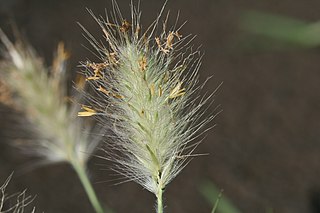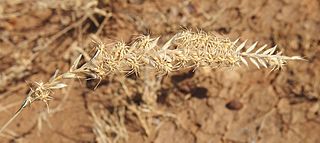
Astrebla Downs is a national park in Shire of Diamantina, Queensland, Australia.

Diamantina National Park is a national park in the Channel Country of South West Queensland, Australia, 1,278 km (794 mi) west of Brisbane. Like the Diamantina River that flows through it, it is named for Lady Diamantina Bowen, wife of Sir George Bowen, the first Governor of Queensland.

Pennisetum is a widespread genus of plants in the grass family, native to tropical and warm temperate regions of the world. They are known commonly as fountaingrasses. Pennisetum is considered a synonym of Cenchrus in Kew's Plants of the World Online.

The Barkly Tableland is a rolling plain of grassland in Australia. It runs from the eastern part of the Northern Territory into western Queensland. It is one of the five regions in the Northern Territory and covers 283,648 square kilometres (109,517 sq mi), 21% of the Northern Territory. The Barkly Tableland runs parallel to the southern shore of the Gulf of Carpentaria, from about Mount Isa, Queensland to near Daly Waters.

Themeda triandra is a perennial tussock-forming grass widespread in Africa, Australia, Asia and the Pacific. In Australia it is commonly known as kangaroo grass and in East Africa and South Africa it is known as red grass and red oat grass or as rooigras in Afrikaans. Kangaroo grass was formerly thought to be one of two species, and was named Themeda australis.

Astrebla is a small genus of xerophytic grasses found only in Australia. They are the dominant grass across much of the continent. They are commonly known as Mitchell grass after Scottish explorer, Thomas Mitchell, who first collected a specimen near Bourke in New South Wales.

Danthonia is a genus of Eurasian, North African, and American plants in the grass family. Members of this genus are sometimes referred to as oatgrass, but that common name is not restricted to this genus. Other common names include heathgrass and wallaby grass. Australian species have since been reclassified into the genus Rytidosperma.

Mallee Woodlands and Shrublands is one of 32 Major Vegetation Groups defined by the Australian Government Department of the Environment and Energy.

Centotheca is a genus of African, Asian, and Pacific Island plants in the grass family.

Pennisetum villosum is a species of flowering plant in the grass family Poaceae, known by the common name feathertop grass or just feathertop. It is native to northeastern Africa and parts of the Arabian Peninsula, and it is grown elsewhere as an ornamental plant. It can sometimes be found growing wild where it has escape cultivation. This is a perennial grass growing in rhizomatous clumps, producing erect stems up to about 75 centimeters tall. The inflorescence is a panicle of clustered spikelets surrounded by a cloudlike mass of plumose white bristles up to 5 centimeters long.

Krameria lappacea, the para rhatany and Peruvian rhatany, is a plant species in the genus Krameria, in Peru. It is a slow-growing shrub that grows in semi-arid areas of the Andean region. The Latin specific epithet of lappacea is derived from lappa meaning with burrs.

Eucalyptus ochrophloia, commonly known as the yapunyah, is a species of eucalypt native to inland New South Wales and Queensland in eastern Australia.

Davenport Downs Station is a pastoral lease that operates as a cattle station in Queensland.

Astrebla pectinata, commonly known as barley Mitchell grass, is a herb of the family Poaceae from the order Poales.

Astrebla elymoides, commonly known as hoop Mitchell grass, is a herb of the family Poaceae. Named in honour of Thomas Mitchell, it is regarded as the best of the Astrebla grasses for grazing, particularly for cattle. Often seen growing to one metre tall, on floodplains and heavy self mulching clay soils in arid to semi arid Australia. Flowering is in response to rain or flooding.

Astrebla squarrosa, commonly known as bull Mitchell grass, is a long lived herb of the family Poaceae. Named in honour of Thomas Mitchell, it is regarded as the most flood tolerant of the Astrebla grasses. Often seen growing to 1.5 metres tall, on floodplains and heavy dark clay soils in arid to semi arid Australia. The coarse stems and difficult digestibility make this a less desirable Mitchell grass for livestock. Flowering is in response to rain.

The Mitchell Grass Downs is a tropical and subtropical grasslands, savannas, and shrublands ecoregion in northeastern Australia. It is a mostly treeless grassland, characterised by Mitchell grasses .

Tourrettia is a monotypic genus of flowering plants belonging to the family Bignoniaceae. It only contains one known species, Tourrettia lappacea(L'Hér.) Willd. The genus of Tourrettia has 2 known synonyms, DombeyaL'Hér. and MedicaCothen. It is also in Tribe Tourrettieae.


















